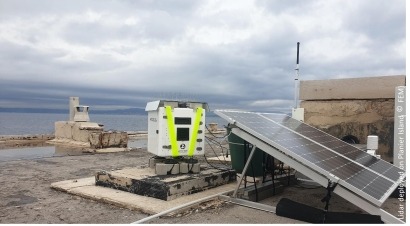
This phenomenon, which exists naturally, generates vortex structures that put a great deal of stress on the wind turbines and impact the wake between machines within the wind farms.
In the Gulf of Lion, direct measurements of wind and wind turbulence are currently collected by a network of coastal anemometers. However, offshore data are needed to feed the numerical models used to characterize the resource and to design the systems.
While the installation of anemometers on masts deployed offshore is ruled out, due to their high cost of installation, operation and maintenance, the use of remote sensing devices such as profiling lidar is promising.
Similar to radar but emitting pulses of infrared light instead of radio waves, this type of sensor measures the return time after reflection from the target. This technology is less expensive than the use of anemometers at sea and is now certified for wind resource estimation. On the other hand, it is not widely used to characterize wind turbulence, which is what the POWSEIDOM collaborative research project aims to address.
Due to the lack of wind and turbulence data from direct measurements in the Gulf of Lion, the POWSEIDOM project partners deployed a Vaisala WindCube v2.1 profiling lidar (certified according to IEC 61400-12-1) on the island of Planier on December 8, 2022.
This site was chosen because it is an island with no major relief, which makes it possible to capture undisturbed atmospheric phenomena and therefore representative of offshore conditions, like those of future pilot farm sites in the Mediterranean.
This campaign will allow a study the evolution of the strong onshore winds’ characteristics of the Gulf of Lion, which generate winter storms that induce a lot of turbulence. At the end of the 12 months of measurements, the first ever Mediterranean database of wind and turbulence data acquired at sea and continuously will be compiled.
While the information on average wind speed and direction is of interest to all users in the area, the information on turbulence intensity is of considerable interest to wind farm developers. The measurements acquired at sea will be implemented in the new turbulence intensity reconstruction algorithm developed by the project team. The time series generated at different altitudes will provide valuable data for optimizing the design of wind turbines and increasing the profitability of projects.

